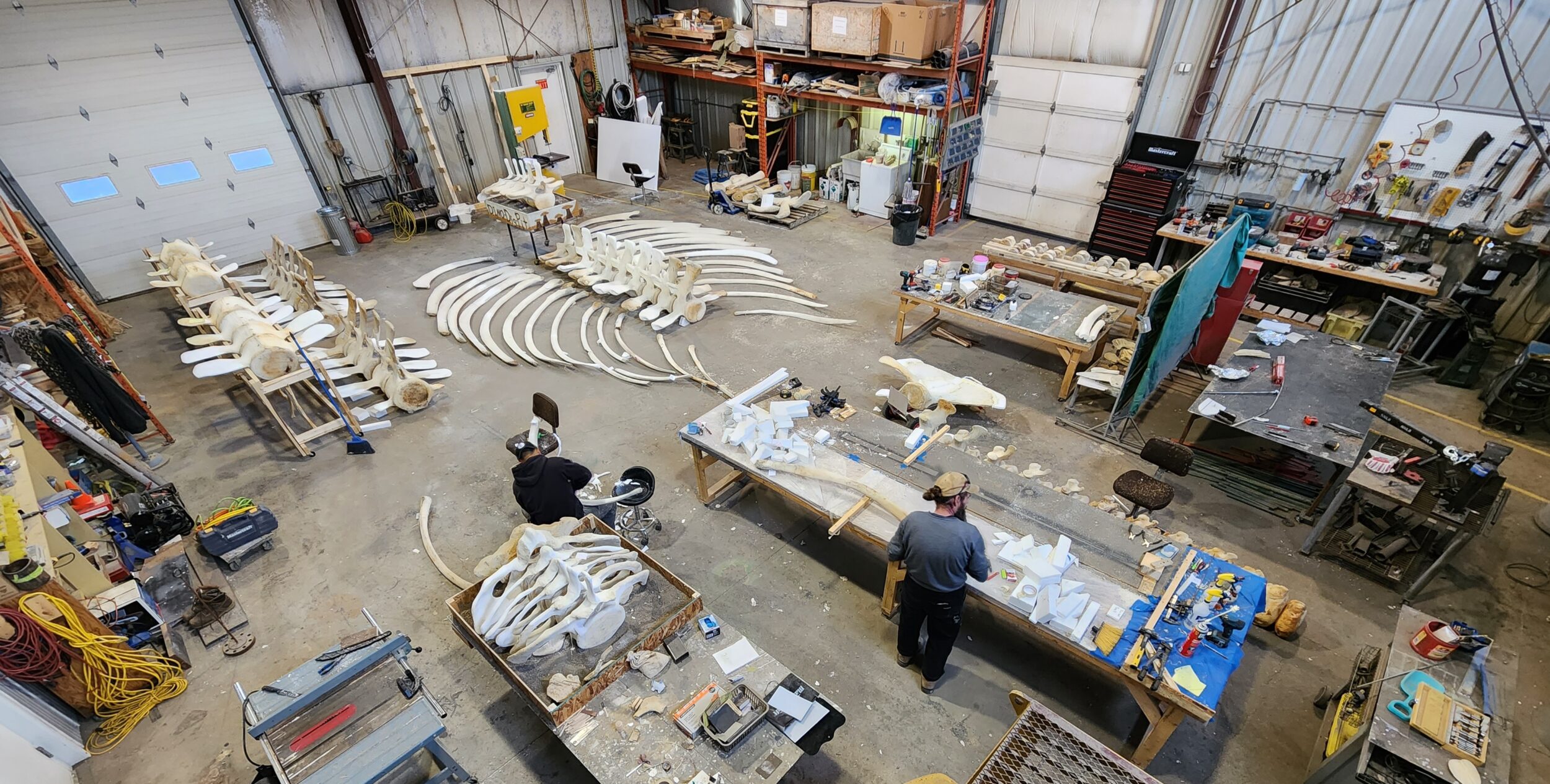
By DANA TIMS/YachatsNews
Discovery nearly a decade ago of a dead blue whale on the southern Oregon coast drew flocks of sightseers and scientists, all curious to gape at and inspect the relatively intact remains of the largest animal ever to populate the planet.
Few, however, guessed that it wasn’t the end of the line for the 200 ton, 70-foot-long specimen of power and wonder. In fact, the whale’s final migration is still just around the corner.
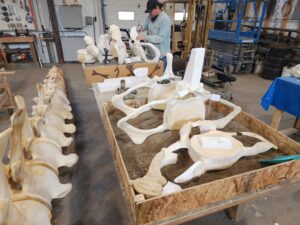
Today, reconstruction artists working in a sprawling warehouse near Calgary, Alberta are putting finishing touches on an effort to “rearticulate” and install the skeleton in a few months for permanent display outside the Hatfield Marine Science Center in Newport.
“It’s almost impossible to describe how awe-inspiring this will be for years and years to come,” said Lisa Ballance, director of Oregon State University’s Marine Mammal Institute. “It’ll be an incredible sight.”
When completed, the 5,000-pound finished product will be one of only six complete blue whale skeletons on display in the United States and one of maybe two dozen anywhere in the world.
“Blue whales are astonishing animals, but their strandings rarely take place in areas that are easily accessible,” Ballance said. “And it’s even more rare to have one end up so close to Hatfield. This was a really astounding confluence of events.”
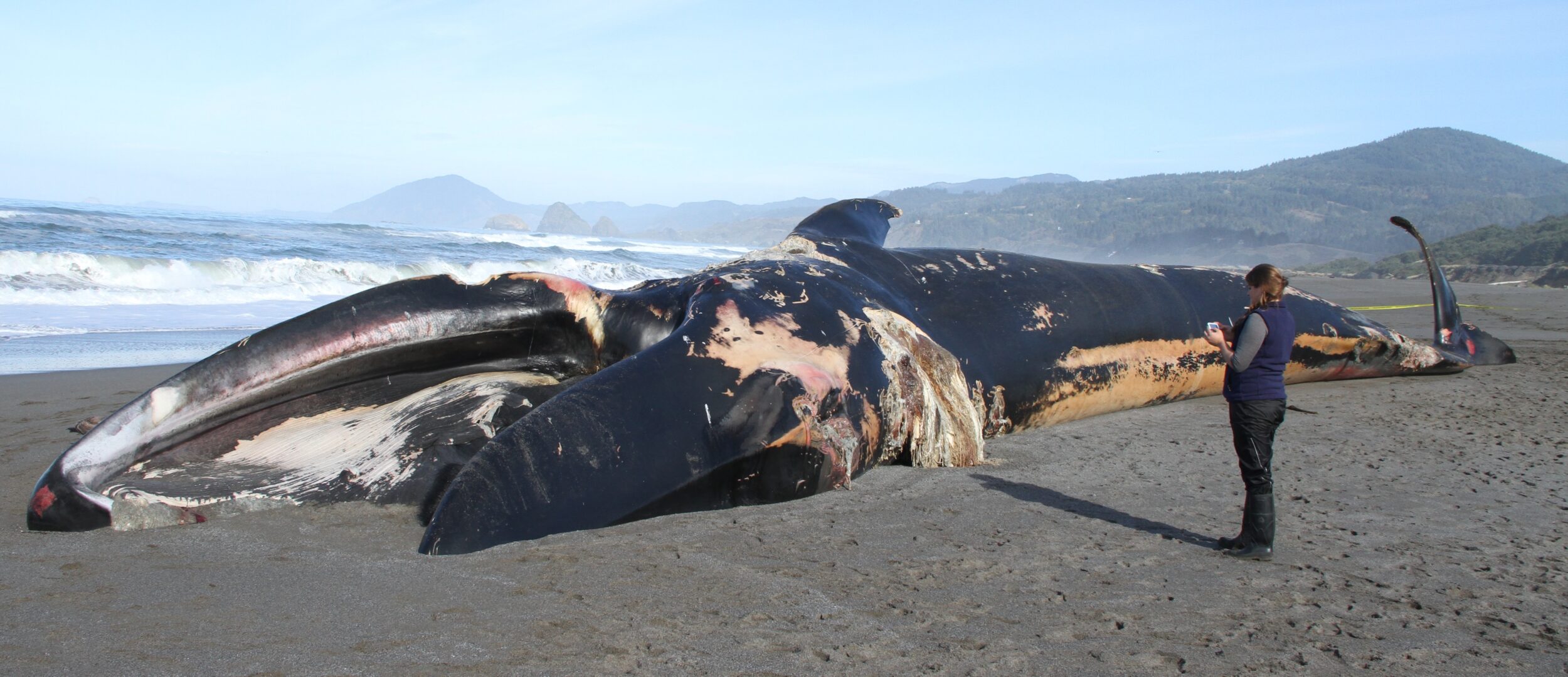
From surf to sand
The story of the whale’s retrieval is nearly as remarkable as the skeleton itself.
The call came into the Hatfield Center in November 2015. A huge whale was tumbling and rolling in and barely out of the surf on a beach just north of the mouth of the Rogue River near Gold Beach. Jim Rice, who manages the Marine Mammal Stranding Network for the entire Oregon coast, was among the first experts to arrive.
The whale’s advanced state of decomposition suggested it had been dead about a week. The necropsy Rice performed – the animal equivalent of an autopsy – indicated several health issues.
The adult male whale was underweight, indicating it wasn’t eating properly prior to its death. Tissue samples indicated the presence of the bio-toxin domoic acid, which even if not fatal, could still have impaired the whale’s ability to travel, feed normally and fend off predators.
However, obvious signs of blunt force trauma and bruising to the skull, right lower jaw, abdomen and tail areas in front of the flukes, all pointed to a collision with a large vessel as the most obvious cause that led to its death.
Rice attributed the large open wound and multiple tooth marks on the whale’s head to post-mortality scavenging from orcas.
For most large-animal beach strandings, that would have wrapped matters up, leaving disposal of the carcass the only remaining question. But Rice and Bruce Mate, then the head of OSU’s Marine Mammal Institute, had a far more ambitious vision — salvaging the skeleton for future public display.
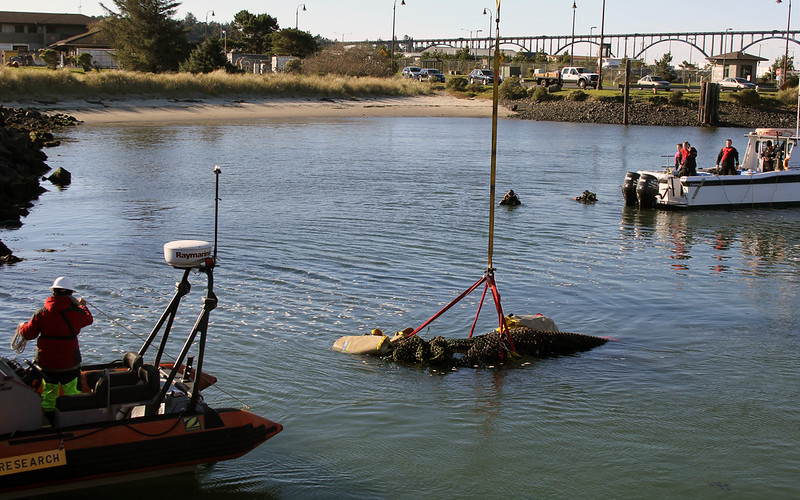
Bags of bones
So a small army of nearly 50 scientists and volunteers, working both in and out of the surf for nine grueling days, carefully cut the skeleton up, placed its harvested bones in bags crafted from repurposed fishing nets, loaded everything onto flatbed trailers and hauled them north to Newport.
There, in April 2016, a large crane carefully lowered the bags into the waters of Yaquina Bay outside the Hatfield Center, where they were weighted to the seabed by steel cables and heavy railroad wheels. Everyone then stepped back to let salt water, crabs and other marine creatures do the initial work of stripping the fleshy tissues that remained.
By the time the bags were hoisted back up in November 2019, Ballance had taken over from Mate as the institute’s director. Working together, they tackled the question of how to transform their vision of a full skeleton into reality.
The answer, it turned out, lay nearly 1,000 miles northeast in south-central Canada in an area best known for dinosaur tourism.

Where blue whales meet dinosaurs
Ballance and Mate knew they needed to find professional expertise. The contract they let was won by Dinosaur Valley Studios, an outfit started in 2006 in Alberta’s Drumheller Valley by Frank Hadfield, still its president and chief executive officer.
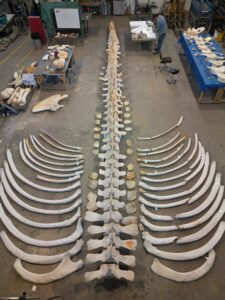
The valley rests in the heart of some of the most gripping dinosaur discoveries ever made. Its Royal Tyrrell Museum of Paleontology, for instance, hosts Canada’s largest collection of dinosaur fossils and boasts 375,000 visitors a year, the largest provincial museum attraction in that country.
It was just the place, in other words, for a little reconstructive work on a Pacific blue whale that, when alive, dwarfed in weight any dinosaur that ever lived.
“We had already done humpback whales, sperm whales and larger orcas, so we were familiar with what it would take,” said Hadfield, an expert welder and fabricator who originally moved to the area to continue his paleontology work. “But the sheer scale of this project meant we couldn’t take it lightly. We needed to be realistic about what was ahead of us, and we knew it was a lot.”
The biggest challenge was extracting as much of the oil as possible out of the whale’s porous bones. That oil, after all, was precious and plentiful enough as lamp fuel that it got blue whales hunted nearly to extinction by the early 1900s.
Hadfield and his staff of four currently are relying on non-invasive methods, using extended baths in warm water to complete the work. While a couple of “problem areas” in the lower jaw and tail vertebrae remain, he estimated that oil extraction is 90 percent complete and that his studios’ work with the project has reached the halfway point.
Hadfield is also designing the steel cradle, or “armature,” that will hold the finished skeleton. He added that he’s particularly pleased that no steel rods will pass through the mount itself.
The finished work will be clear-coated to ensure that it remains bleached white to withstand a marine environment that specializes in rust and ruin.
Striking a pose
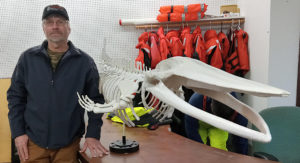
The final task, before hauling the bones back to Newport and final assembly, is figuring out how to pose the massive skeleton. Hadfield is working with Ballance and others on presenting the whale in a foraging position so that it appears dynamic, yet realistic based on known blue whale feeding behaviors.
“There’s been a tremendous amount of research by so many that has gone into this entire work,” Hadfield said. “Just to have this experience at all is quite rare.”
One unanticipated step Hadfield and his crew had to take was replicating the whale’s skull, which was no small task. The jaw bones alone, after all, are 18 feet long. The task proved necessary since the vessel strike that almost certainly led to the whale’s death left the skull in what Hadfield called “extremely poor condition.”
“It would have cost so much to preserve the cranial vault,” he said, “that we recommended carving a replicate, instead.”
If Hadfield has any remorse, it’s that the whale’s vestigial hipbones were never recovered. Researchers believe those are remnants of what were once hind legs, since all whales, dolphins and porpoises once walked the earth before their ultimate journey to the sea.
“What we have in front of us,” he said of the entire project, “is an amazing opportunity to show the evolution of these amazing creatures.”
The last migration
Oregonians and others are used to watching the bi-annual parade of gray whales finning up and down the coast for summers off Alaska and winters in the warmer waters of Baja, Mexico.
Blue whales, their far larger counterparts, aren’t as evident, but only because they travel farther from the shore.
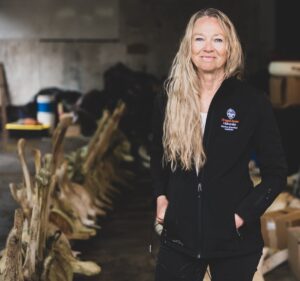
“They tend to migrate toward higher latitudes, where the water is very productive,” Ballance said. “And that includes the Oregon coast, where there are actually periodic hot spots of blue whales.”
That they are there at all, decades after being hunted nearly to extinction, is something of a miracle. Their protection under two federal marine-preservation acts has helped spawn a comeback story for the ages.
“And for all we know, they may still be increasing in numbers,” Ballance said. “It’s a huge success story in what can happen to a population when you just stop killing them.”
This spring or early summer, the public will get a close-up sense for what makes this largest of all animal species so special.
The project’s total $450,000 price tag is still short $100,000 of its goal. Ballance is hoping the excitement of the unveiling will help open a few more wallets to raise the rest.
“Skeletons tell all kinds of stories,” she said. “I really think this one will be more incredible than most.”
- Dana Tims is an Oregon freelance writer who contributes regularly to YachatsNews.com. He can be reached at DanaTims24@gmail.com
(Editor’s Note: The blue whale skeleton mounted outside the Beaty Biodiversity Museum at the University of British Columbia is fondly known as “Big Blue.” Outside the Santa Barbara Museum of Natural History, meanwhile, “Chad” is adored by thousands each year. But Oregon’s own soon-to-be public blue whale skeleton? Not a friendly moniker in sight. So we thought we’d ask readers to send their suggestions our way in the comments section below. We’ll pass them on to the Marine Mammal Institute to possibly help get this whale a proper name).



This story is incredible – I learned more about the blue whale than I ever knew. It was so interesting I even surfed the net for more information. Thank you Dana for sharing this great story with all of us – very well written and it held my attention throughout the article, like reading a book I couldn’t put down. All those pictures only enhanced what you were telling us about what became of that blue whale that washed up on our Oregon beach.
<>
“Finneas” or “Finley”
OK – Here is my submission for naming Oregon’s own blue whale skeleton: Azure – the “Sea Voyager” Azure – for the color blue according to various dictionary’s and the “Sea Voyager” describes the activity of the blue whale. . . . or simply name it Azure!
I know one of OSU’s ship captains who got to work on getting the whale bones put into bags. He said it was grueling work with the oils of the whale being slippery and how cold it was, his knife was very hard to hold onto for hours on end. For that reason I’d like its name to be “Captain”.
Let’s call him “True Blue,” which only begins to point to what a life this magnificent being must have had, what he must have endured and then to finally offer his remains to us on the perfect shore. Now his bones will serve as a reminder that this creature of distinction lived among us, beyond us actually, and deserves our deepest respect.
Seeing “True Blue” as a name reminded me that 50 years ago, when the Oakland A’s were owned by Charles O. Finley, he offered pitcher Vida Blue a pile of money to change his name to True Blue. It never got changed..
I like the name “Journey” for this magnificent whale. I think about the journey of Blue Whales, their fascinating evolution as an age old species, being hunted to near extinction, and now having to adjust to and survive in ocean waters that are no longer so pristine or hospitable. Our world would not be the same without them, and this whale’s journey will continue by showing many, many people the beauty and awe of what we came close to losing, and could still lose.
They could call it BLUE BY YOU to help with the funding
Ophir Blue … it was found on Ophir Beach
Awesome article and I am anxious to see finished product.
What a fascinating story. I love whales, and have collected all things whale for years. I was born in Gold Beach. Having moved away several years ago, I knew nothing of this until I read the story today.
Golden Journey to signify where he was found; and to honor all that have participated in his final journey home.
How about bluey?!
Bluey flipper the blue whale
I think “Phineas” or “Berry” would be a good name for this beautiful whale. Get it… PHINeas? And it’s a cool name in general, I think. Such a cool project!! Can’t wait to see the whale up at Hatfield.
Or “Balae” – said like Baylee – for Balaenoptera musculus
“Bruce” would be a good name for the whale.
What about the name for blue whale in an indigenous language local to the area?
Great article!
I suggest the name “Alex” for the whale. My granddaughter is studying at OSU to be a marine biologist and her name is Alexandra. She sometimes goes by Alex though.